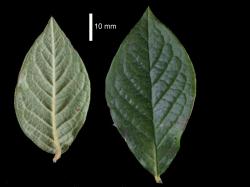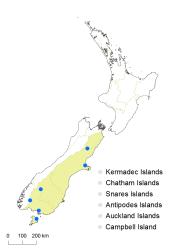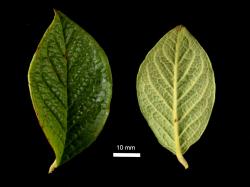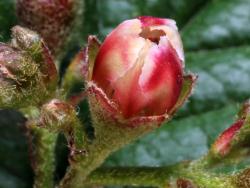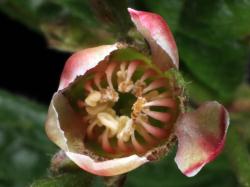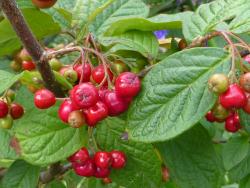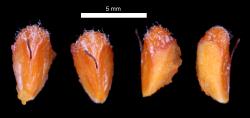Erect shrub to 3 m tall, deciduous. Branches in flattened planes or not; branchlets grey-brown to red-brown, lenticels present, sometimes striate, sometimes with peeling cuticle, branchlet hairs sparse, yellow; stipule 3.2–4.0 mm long, red, hair moderately dense to dense, yellow to brown. Leaves crowded on branches, 50–128 mm long, lamina 48–125 mm long, 33–68 mm wide, elliptical, plane or slightly V-shaped, 150–240 µm thick, petiole 2–7 mm long, hairs moderately dense, pale yellow; leaf base obtuse; leaf apex acute, acuminate or obtuse, apiculus straight, occasionally bent downwards; lateral veins in 6–10 pairs, midvein and lateral veins impressed above and projecting below, upper surface rugose, dull, upper surface hairs sparse; margins plane, hairs absent to moderately dense, white or yellow; lower surface glaucous or not, hairs moderately dense, yellow, densest on midvein and lateral veins.
Inflorescence a corymb or compound corymb of 5–37 flowers, 25–64 mm long, rachis hairs moderately dense, yellow; pedicels 1–9 mm long, hairs absent or sparse, yellow. Flowers 4.5–5.5 mm diameter. Hypanthium green, sepals 1.5–2.0 mm long, 2.3–2.5 mm wide, sepal margins sometimes red, hairs absent to sparse, yellow. Petals pink to red in bud, when open erect, red centrally with pink or white margins, 3.0–4.5 mm long, 3.0–3.2 mm wide, base somewhat clawed, glabrous, margins entire to torn. Stamens 17–22; filaments 1.6–2.7 mm long, white to pink; anthers white, 1.0–1.1 mm long; styles 4–5, 1.5–2.3 mm long. Fruit vivid red (RHS 45A), slightly obovoid to obovoid, 8.5–10.5 mm long, 8.0–10.4 mm diameter, calyx closed, glabrous except for a few hairs at base and calyx. Pyrenes 4–5, 4.5–6.0 mm long, 2.2–3.4 mm wide, hairs sparse to moderately dense in upper third at apex, umbonate, style attached 2.0–2.9 mm below pyrene apex (i.e., c. halfway between base and apex).
Lu & Brach (2003) recognise Cotoneaster bullatus var. macrophyllus. Dickoré & Kasperek (2010) do not recognise the variety. Fryer & Hylmö (2009), Fryer et al. (2014), and Verloove (2014) recognise it as a species (C. rehderi Pojarkova). Some New Zealand specimens have been identified as C. bullatus var. macrophyllus. Principal components analysis using lamina length, width, pyrene number, and 18 New Zealand specimens at CHR show that variation in specimens is mostly due to variation in leaf length, with variation in style/pyrene number not correlated to leaf length or width. Specimens formed a single group in the analysis. It appears that in New Zealand there is one variable entity, best regarded as C. bullatus var. bullatus.
A large-leaved deciduous shrub to 2 m tall, strongly rugose, veins prominent below, 5–11 flowers per corymb. Petals erect with a small opening, white with a red cross. Styles/pyrenes 4–5 per flower/fruit, usually variable on a single plant but sometimes 5 per flower/fruit.
Cotoneaster moupinensis is also deciduous, with leaves rugose (although less strongly so), and has leaves comparable in size to small-leaved specimens of C. bullatus (lamina c. 63–71 × 32–40 mm, cf. lamina 48–125 mm long, 33–68 mm wide in C. bullatus). Both have erect petals that are red centrally and white at the margins. The fruit of C. moupinensis is black (not vivid red) and pyrenes 2–3 (not 4–5). Cotoneaster moupinensis is not currently known to be present in New Zealand.
Cotoneaster coriaceus has rather similar hairs that tend to be yellow or yellow-brown. It has thicker-textured leaves than C. bullatus, which are only slightly rugose, and they are evergreen, not deciduous. Cotoneaster coriaceus has pink-tinted petals, rather than white petals, with a distinctive red central cross. It has 2 pyrenes per fruit, not 4–5.
Canterbury (Hanmer—Conical Hill, 1988; Port Hills—Victoria Park, 1997), Otago (Queenstown, 1982), Southland (Monowai, 2015; Invercargill—Thomsons Bush, 1986), Stewart Island (Halfmoon Bay, 2005–2008)
CHR 461288, W.R. Sykes 139/82, 13 March 1982, Queenstown Government Gardens, in scrub under Pseudotsuga plantation
Flowering: mid October to early January; Fruiting: March onwards, not persisting over winter
Tetraploid (Fryer & Hylmö 2009, p. 223)



